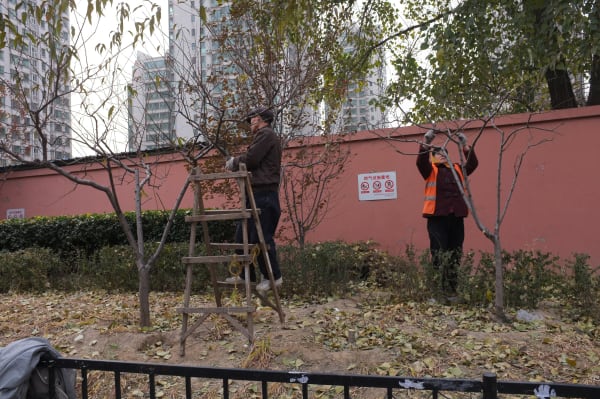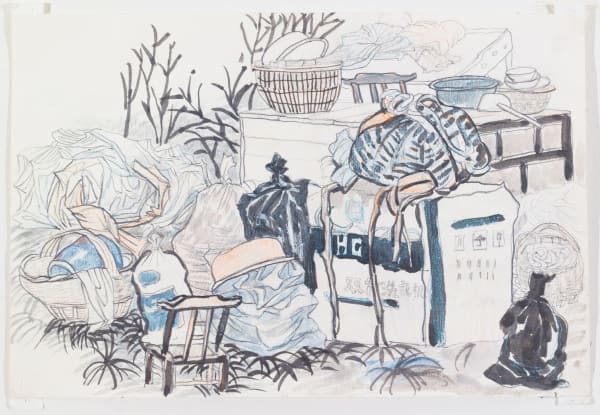-
-
This Viewing Room invites visitors to take a closer look at Yun-Fei Ji's epic scroll The Village and its Ghosts. The 57-foot-long scroll tells the story of a fictional village that at first glance appears to be a picturesque mountain refuge, like those that populate classical Chinese landscape painting. Upon deeper examination, a more nuanced and contemporary reality is revealed.
-
 Click for further details
Click for further details -
As we move through the unfolding narrative of the scroll, we encounter a community experiencing monumental social and ecological transformation. Ji traces the history of China’s industrial revolution and rise as a global superpower through the microcosmic lens of life in this imaginary village. The result is an elegiac and at turns supernatural lament for a way of living eradicated by the steady march towards "progress."
-
-
"The choice of the handscroll format presupposes a particular way of seeing, for viewing a handscroll evokes a physical and psychological journey: time passes and events unfold as we move along the scrolls."¹
- Anita Chung -
-
Ji masterfully employs the traditional techniques of classical scroll painting. The ink and watercolor compositions possess an immediacy that suggest a splintered, at times surreal, contemporary landscape. Delicate feathering denotes the furred limbs of cloven-hoofed, berobed monsters, while dense passages of wash define the mountainside beneath their feet.
-

Detail
-

Detail
-
"I try to mimic the method that underlies the formation of early Chinese characters: I invent forms that are like words to describe the world."²
- Yun-Fei Ji
-
-

Francisco de Goya, The Burial of the Sardine (Corpus Christi Festival on Ash Wednesday)/ El Entierro de la Sardina (Corpus Christi Festivo el miércoles de Ceniza), 1812-1814.*
-

Detail
-
“I like to make weighty subjects humorous. I incorporate ghosts to treat stories with a certain lightness, but also to add a certain darkness. To only represent one side of things is not enough; you have to dig deeper to understand the people, their stories, their culture, and beliefs, and incorporate this into a visual language.”
- Yun-Fei Ji
-
-

Detail
-

-
-
Often, the solitary, individualized villagers that appear in Ji’s compositions speak to environmental concerns. Here Ji depicts workers painstakingly pollinating flowers by hand, in trees once populated by abundant fruit. The bee population around the globe is in a dramatic state of decline. China has become the first country to implement hand pollination on a massive scale. Once the work of bees, this scene becomes emblematic of the destruction wrought on our environment in the name of China's "great leap forward."
-
-
“The scale of the scroll is balanced by the specificity of its detail, recognizing the individual lives . . . This person-to-person contact is evident in the particular faces and gestures of villagers packing up their lives, their children, their elderly family members, and their belongings."³
- Katy Siegel
-

-
"The artist’s approach, which unites cultures and reveals shared experiences, points to a broader commitment to understanding the Other as a translation of the Self."
- Tracy Adler, Johnson-Pote Director of the Wellin Museum of Art
-
-

-
ADDITIONAL AVAILABLE WORK
This series of ink, graphite and watercolor sketches illustrates Ji’s evolving process. Each work is a vignette that reveals his empathetic focus on the material evidence of migration and forced relocation: the things people take with them when they are forced to leave home.
-
-
 YUN-FEI JI, Untitled, ca. 2012$ 8,500.00
YUN-FEI JI, Untitled, ca. 2012$ 8,500.00 -
 YUN-FEI JI, Untitled, ca. 2012$ 8,500.00
YUN-FEI JI, Untitled, ca. 2012$ 8,500.00 -
 YUN-FEI JI, Untitled, ca. 2012$ 8,500.00
YUN-FEI JI, Untitled, ca. 2012$ 8,500.00 -
 YUN-FEI JI, Untitled, ca. 2012$ 8,500.00
YUN-FEI JI, Untitled, ca. 2012$ 8,500.00
-
 YUN-FEI JI, Untitled, ca. 2012$ 8,500.00
YUN-FEI JI, Untitled, ca. 2012$ 8,500.00 -
 YUN-FEI JI, Untitled, ca. 2012$ 8,500.00
YUN-FEI JI, Untitled, ca. 2012$ 8,500.00 -
 YUN-FEI JI, Untitled, ca. 2012$ 8,500.00
YUN-FEI JI, Untitled, ca. 2012$ 8,500.00 -
 YUN-FEI JI, Untitled, ca. 2012$ 8,500.00
YUN-FEI JI, Untitled, ca. 2012$ 8,500.00
-
-
_______________________________________________________________________________
Lead Image: Installation view, Yun-Fei Ji: The Intimate Universe, Ruth and Elmer Wellin Museum of Art, Hamilton College, Clinton, NY, February 6 - July 2, 2016
*Full Details: Francisco de Goya, The Burial of the Sardine (Corpus Christi Festival on Ash Wednesday)/ El Entierro de la Sardina (Corpus Christi Festivo el miércoles de Ceniza), 1812-1814, oil on panel, 23 ⅓ x 32 ⅓ in (60 x 82 cm). Colección de Real Academia de Bellas Artes de San Fernando, Madrid, Spain.
¹Chung, Anita, Ji Yun-Fei: Last Days of Village Wen, exh. cat., Cleveland Museum of Art, 2016. p. 14.
² Yun-Fei Ji, as quoted in Knafo, Robert, "Yun-Fei Ji: Moral Vistas," Art in America, 91 (6): 104–137, 2003
³Ji, Yun-Fei, Katy Siegel, and June Y. Mei, "Three Gorges Dam Migration." Art Journal 69, no. 3 (2010): 73-78.
Adler, Tracy, et. al., Yun-Fei Ji: The Intimate Universe, New York: DelMonico Books•Prestel and Wellin Museum of Art, Hamilton College, 2016.
Yun-Fei Ji's The Village and Its Ghosts: A Closer Look: Online Viewing Room
Past viewing_room
























